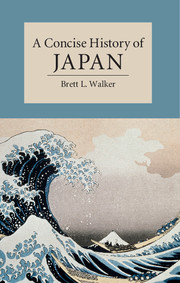Book contents
- Frontmatter
- Dedication
- Contents
- List of Illustrations
- List of Maps
- Preface
- Chronology
- Introduction
- 1 The Birth of the Yamato State, 14,500 bce – 710 ce
- 2 The Courtly Age, 710–1185
- 3 The Rise of Samurai Rule, 1185–1336
- 4 Medieval Japan and the Warring States Period, 1336–1573
- 5 Japan’s Encounter with Europe, 1543–1640
- 6 Unifying the Realm, 1560–1603
- 7 Early Modern Japan, 1600–1800
- 8 The Rise of Imperial Nationalism, 1770–1854
- 9 Meiji Enlightenment, 1868–1912
- 10 Meiji’s Discontents, 1868–1920
- 11 The Birth of Japan’s Imperial State, 1800–1910
- 12 Empire and Imperial Democracy, 1905–1931
- 13 The Pacific War, 1931–1945
- 14 Japan’s Post-War History, 1945–Present
- 15 Natural Disasters and the Edge of History
- Glossary
- Further Reading
- Index
13 - The Pacific War, 1931–1945
Published online by Cambridge University Press: 05 March 2015
- Frontmatter
- Dedication
- Contents
- List of Illustrations
- List of Maps
- Preface
- Chronology
- Introduction
- 1 The Birth of the Yamato State, 14,500 bce – 710 ce
- 2 The Courtly Age, 710–1185
- 3 The Rise of Samurai Rule, 1185–1336
- 4 Medieval Japan and the Warring States Period, 1336–1573
- 5 Japan’s Encounter with Europe, 1543–1640
- 6 Unifying the Realm, 1560–1603
- 7 Early Modern Japan, 1600–1800
- 8 The Rise of Imperial Nationalism, 1770–1854
- 9 Meiji Enlightenment, 1868–1912
- 10 Meiji’s Discontents, 1868–1920
- 11 The Birth of Japan’s Imperial State, 1800–1910
- 12 Empire and Imperial Democracy, 1905–1931
- 13 The Pacific War, 1931–1945
- 14 Japan’s Post-War History, 1945–Present
- 15 Natural Disasters and the Edge of History
- Glossary
- Further Reading
- Index
Summary
In the 1930s, Japan’s culture of fascism shaped its politics, culture, and foreign affairs. Military adventurism in Manchuria and political assassinations at home led to the fall of party politics and the rise of military governance, wherein generals, admirals, and their lieutenants occupied top cabinet posts. After 1931, the Kwantung Army conquered much of Manchuria and Tokyo eventually accepted these territorial gains as fait accompli. The birth of Japan’s autarkic empire (Map 3) paralleled these military victories; incensed with irksome diplomacy, Japan withdrew from the League of Nations and most of its international agreements. With a full-fledged invasion of China after 1937, Japan waged the so-called ‘Greater East Asian War’, eventually attacking Pearl Harbor (1941) and drawing the US into the conflict. For both sides, racism, cultural misunderstanding, and sheer mercilessness characterized the fighting. The historical currents that led to the dramatic collapse of party politics and the rise of militarism had their roots in imperial nationalism and the Meiji Constitution, which had isolated the military from the turgid malaise of parliamentary politics. Japan’s military always stood beyond the political fray and in the popular imagination easily transcended the corruption of liberal economics and politics, which became strongly associated with the excesses of US individualism and greed.
The Pacific War exacted a heavy toll on all involved. Millions died in the Pacific theatre as a result of Japanese expansionism; domestically the Japanese, though initially enthralled with the exuberant culture of total war, began suffering through the so-called ‘dark valley’ as defeat loomed on the horizon. By 1945, the US and its Allies had crippled Japan’s domestic industrial and military machinery, and with the atomic bombing of Hiroshima and Nagasaki, Japan ‘unconditionally surrendered’. The seven-year US occupation of Japan that followed the war witnessed profound and widespread changes in Japanese political institutions, law enforcement and defence, education, economics and popular culture, the legacies of which have shaped Japanese society throughout the post-war years.
- Type
- Chapter
- Information
- A Concise History of Japan , pp. 240 - 260Publisher: Cambridge University PressPrint publication year: 2015



